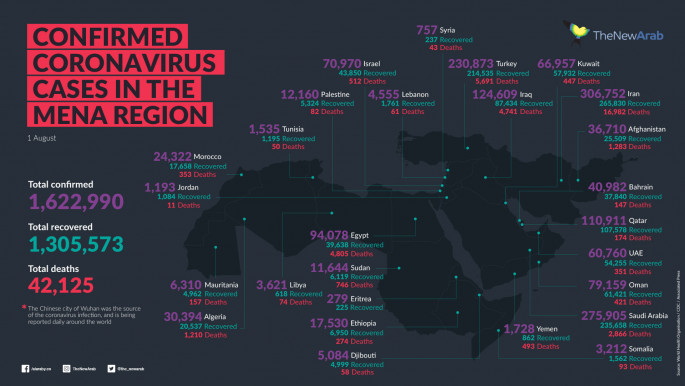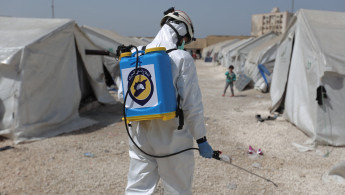Syria Weekly: Fears over an 'under the radar' coronavirus epidemic
Lockdowns in regime areas and the relative calm on the Idlib border might have slowed the spread of the disease, but aid agencies have warned that Syria still remains highly vulnerable to an outbreak of Covid-19.
On Saturday, the Syrian regime announced the biggest number of coronavirus cases in one day, when 11 Syrians returned from Kuwait and tested positive for the disease. Aid groups and activists, meanwhile, fear the outbreak is much more widespread in regime areas than is being officially reported.
Testing deficit
Healthcare workers are also concerned by the low level of testing in the country. The northeastern Syria region has the second lowest number of tests per capita in the world, with only 59 tests per million people, the International Rescue Committee (IRC) reported on Friday.
In comparison, the UK, which has conducted 41,599 tests per million, has still seen more than 40,000 Covid-19 related deaths.
The low number of tests means that coronavirus cases in northwest and northeast Syria - both outside regime control - are likely being under-reported, making it near-impossible to track and trace Covid-19 if, or when, a major outbreak takes place.
"There is limited testing capacity in Idlib and northeast Syria, so it is highly likely that the disease is more prevalent in both parts of the country than it currently appears to be," Misty Buswell, regional policy and advocacy advisor at the International Rescue Committee told The New Arab.
In Idlib province, there is only one Covid-19 testing lab and 5,300 test kits for a population of more than 3 million, so healthcare workers are only testing suspected coronavirus cases.
NGO and healthcare workers are still struggling to cope with the humanitarian disaster wreaked by a regime offensive in northern Hama and southern Idlib earlier this year, which uprooted a million people and overwhelmed already critically overcrowded camps in the north of the province.
A Turkish-Russian brokered ceasefire has allowed some families to return to their homes in Idlib, but thousands more are living in makeshift camps, barns and disused buildings.
Added to this, the price for food has shot up by more than 70 percent over the past five months, leaving families with little or no source of income at increasing risk of malnutrition and the disease.
"Families are using their limited resources to buy food and other necessities and aren't able to purchase sufficient water for extra handwashing and other sanitation measures recommended for Covid protection," said Buswell.
"Additionally, the healthcare system in the northwest has been decimated after so many years of conflict and relentless attacks on health facilities. Scaling up from such a low level and preparing to respond to a pandemic that has challenged even the strongest healthcare systems is a massive task."
Northeastern Syria
In northeast Syria, controlled by the autonomous administration, there are only enough kits for 1,500 tests.
The IRC and other aid groups are working hard to raise awareness about coronavirus and prepare for an outbreak that is likely to have devastating consequences for a region where poverty is endemic and effective healthcare services are lacking.
 |
There is limited testing capacity in Idlib and northeast Syria, so it is highly likely that the disease is more prevalent in both parts of the country than it currently appears to be. - Misty Buswell, IRC |
 |
"There is an urgent need to scale-up the response to this pandemic. Humanitarian agencies were already struggling to provide aid to all those in need in both northeast and northwest prior to the outbreak, and now the situation is becoming even more critical," said Buswell.
"We need more funding, more supplies and more medical equipment if we are to prevent a health emergency from unfolding on top of the humanitarian crisis that people are already struggling to live through."
Up until April, the autonomous administration in northeast Syria had no testing facilities and had to send samples to Damascus for analysis, causing dangerous delays in addressing the public health crisis.
It now has four PCR machines - although only two of these are operational - but more labs are being set up and staff trained, Buswell added.
|
|
So far, there has been one death and six confirmed cases of Covid-19 in northeast Syria, mostly in the area of Hassakeh.
Authorities have started to ease the curfew measures put in place at the start of the crisis, which will alleviate the economic hardships for people but could nullify the initial achievements in tackling the disease.
"I feel the mood in the area is that coronavirus has not come to northeast Syria and it is not going to," said Robin Fleming, researcher at the Rojava Information Center (RIC).
"If the luck is good it will not arrive in northeast Syria. It will not spread, and everything will be fine, but there is still the possibility that a pandemic is looming, waiting to come, but the general view is that it is in the past."
International politics
From the start of the crisis, the administration has been beset with problems. Two machines that could have been used in testing were at a hospital that fell to Turkey's Operation Peace Spring which began in October, while the centralisation of international aid has also been a major hurdle.
"At the beginning of the coronavirus scare there was no access to accurate testing and both the UN and World Health Organisation refused to provide directly to northeast Syria," Fleming said.
Coronavirus aid through these agencies has been directed through Damascus, with distribution to other parts of Syria at the whim of the Syrian regime.
Fleming said all UN and WHO aid sent to northeastern Syria, via Damascus, has ended up at hospitals controlled by Bashar Al-Assad's regime.
 |
There is still the possibility that a [Covid-19] pandemic is looming, waiting to come, but the general view is that it is in the past. - Robin Fleming, RIC |
 |
The centralisation of international Covid-19 assistance through the Syrian regime - well-known for using aid as a weapon during the war - will further hinder efforts in curbing the spread of the novel coronavirus.
"The core of this issue is that northeastern Syria lacks official status and is autonomous from the Syrian regime and [due to this] has received a lot of difficulties in receiving international aid," Fleming told The New Arab.
The aid shortage meant that the administration had to privately purchase five Covid-19 testing facilities after receiving financial assistance from the Kurdistan Regional Government (KRG) in Iraq.
Wladimir van Wilgenburg, co-author of the recently published book The Kurds in Northern Syria, said that the Barzani Charity Foundation, in the KRG region, this week sent more medical aid to northeastern Syria, including anti-inflammatory injections.
"NGOs [in the KRG region] continue to do their work but it's more difficult for them to send aid to the northeast due to anti-coronavirus measures," van Wilgenburg told The New Arab.
"There are limited testing capabilities in the northeast so we do not know the true spread of the virus."
Aid cuts
The administration has also been hampered by Syrian regime allies Russia and China blocking a UN Security Council resolution that would allow medical aid to be sent through the Yaroubiya border crossing with Iraq.
Two of the four border crossings used for humanitarian supplies to northeast Syria closed following Russian pressure, resulting in cuts to between 50 to 60 percent of UN medical aid.
"It's much more difficult to send medical aid by land or flights from Damascus since it needs the permission from the Syrian government," van Wilgenburg added.
"The WHO recently sent a delivery of 30 tons of aid to the area via Qamishli, but the self-administration did not receive anything since it was going to government-linked institutions."
Difficulties in accessing supplies means that half the population in northeastern Syria are classed as "food insecure" by the World Food Programme, living off less than 2,100 calories a day.
 |
There are limited testing capabilities in the northeast so we do not know the true spread of the virus. - Wladimir van Wilgenburg, author and independent journalist |
 |
Russian pressure has also seen UN relief agencies ordered to halt work with any private charities not registered with Bashar Al-Assad's regime when delivering aid to northeastern Syria.
 |
Turkey has also on several occasions cut water supplies to cities such as Hassakeh following disagreements on energy issues, which could further hamper efforts in tackling the coronavirus crisis.
"The economy was already quite bad due to the Syrian pound hitting a record low and the economic crisis in Lebanon. Coronavirus curfews have also impacted shops and businesses," said van Wilgenburg.
The upcoming US-sponsored Caesar Act will see sanctions on the Syrian regime for human rights violations, including torture and mass murder, but could also impact on northeastern Syria.
The autonomous administration is holding talks with Washington to avert northeastern Syria being sanctioned.
Camps
Another concern for authorities in the northeast is the potential spread of Covid-19 in camps holding suspected Islamic State group militants and families.
The largest of these is the densely-packed Al-Hol camp, where the 65,000 population live in very small tents. This makes it a potential hot spot for the spread of Covid-19 due to social distancing being near impossible and issues of poor sanitation.
"On top of that, sanitation conditions across the camp are poor, so if the disease does enter the camp, it's going to spread like wildfire," Misty Buswell said.
Many in Al-Hol also have existing health conditions so if Covid-19 hits the camp then children and elderly people will be extremely vulnerable to the disease.
Thousands more remain displaced in northeastern Syria due to the Turkey-led offensive into northern Syria, living in makeshift camps and communal shelters, Buwell added.
"Outside Al-Hol, the situation is not much better. Other camps, towns and cities are overcrowded too," Buswell said.
"In Hassakeh, hundreds of people are living crammed together in schools that are being used as shelters, and in Raqqa, there are thousands living in informal settlements and dilapidated buildings, with poor sanitation and limited access to healthcare."
Added to this, the large vulnerable elderly population in northeastern Syria - one of the most at-risk groups from Covid-19 - will add further strains to the healthcare system there.
The IRC and other groups are continuing assistance to vulnerable groups through "social distancing" aid distributions and raising awareness about Covid-19 via WhatsApp.
Although many in Syria are hoping they have averted a Covid-19 outbreak, the IRC said that as long as the disease is present in other parts of the world the country remains in danger of an epidemic.
"Although many countries are concerned about their own domestic Covid-19 issues, until the virus is ended everywhere it will remain a threat to everyone," said Buswell.
"It's important not to lose focus on addressing the pandemic in the most fragile states, and support must be provided to the most vulnerable."
Syria Weekly is a regular feature from The New Arab. To get Syria Weekly in your inbox each week, sign up here.
Paul McLoughlin is a news editor at The New Arab.
Follow him on Twitter: @PaullMcLoughlin



